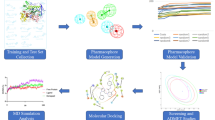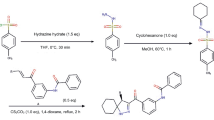Abstract
Acetylcholinesterase (AChE) is one of the key targets of drugs for treating Alzheimer’s disease (AD). Tacrine is an approved drug with AChE-inhibitory activity. In this paper, 3D-QSAR, molecular docking, and molecular dynamics were carried out in order to study 60 tacrine derivatives and their AChE-inhibitory activities. 3D-QSAR modeling resulted in an optimal CoMFA model with q 2 = 0.552 and r 2 = 0.983 and an optimal CoMSIA model with q 2 = 0.581 and r 2 = 0.989. These QSAR models also showed that the steric and H-bond fields of these compounds are important influences on their activities. The interactions between these inhibitors and AChE were further explored through molecular docking and molecular dynamics simulation. A few key residues (Tyr70, Trp84, Tyr121, Trp279, and Phe330) at the binding site of AChE were identified. The results of this study improve our understanding of the mechanisms of AChE inhibitors and afford valuable information that should aid the design of novel potential AChE inhibitors.

Superposition of backbone atoms of the lowest-energy structure obtained from MD simulation (magenta) onto those of the structure of the initial molecular docking model (green).










Similar content being viewed by others
Explore related subjects
Discover the latest articles and news from researchers in related subjects, suggested using machine learning.References
Wimo A, Jönsson L, Bond J, Prince M, Winblad B, International AD (2013) The worldwide economic impact of dementia 2010. Alzheimers Dement 9(1):1–11
Coyle JT, Price DL, DeLong MR (1983) Alzheimer's disease: a disorder of cortical cholinergic innervation. Science 219(4589):1184–1190
Hamulakova S, Janovec L, Hrabinova M, Spilovska K, Korabecny J, Kristian P, Kuca K, Imrich J (2014) Synthesis and biological evaluation of novel tacrine derivatives and tacrine–coumarin hybrids as cholinesterase inhibitors. J Med Chem 57(16):7073–7084
Quinn DM, Feaster SR, Nair HK, Baker NA, Radić Z, Taylor P (2000) Delineation and decomposition of energies involved in quaternary ammonium binding in the active site of acetylcholinesterase. J Am Chem Soc 122(13):2975–2980
Luo W, Li YP, He Y, Huang SL, Tan JH, Ou TM, Li D, Gu LQ, Huang ZS (2011) Design, synthesis and evaluation of novel tacrine-multialkoxybenzene hybrids as dual inhibitors for cholinesterases and amyloid beta aggregation. Bioorg Med Chem 19(2):763–770
Guevara-Salazar JA, Espinoza-Fonseca M, Beltran HI, Correa-Basurto J, Trujillo-Ferrara DQZJG (2007) The electronic influence on the active site-directed inhibition of acetylcholinesterase by N-aryl substituted succinimides. J Mex Chem Soc 2007(51):173–177
Nepovimova E, Uliassi E, Korabecny J, Peňa-Altamira LE, Samez S, Pesaresi A, Garcia GE, Barttolini M, Andrisano V, Bergamini C, Fato R, Lamba D, Roberti M, Kuca K, Monti B, Bolognesi ML (2014) Multitarget drug design strategy: quinone–tacrine hybrids designed to block amyloid-β aggregation and to exert anticholinesterase and antioxidant effects. J Med Chem 57(20):8576–8589
Fernandez-Bachiller MI, Pérez C, Monjas L, Rademann J, Rodríguez-Franco MI, Fernández-Bachiller MI, Pérez C, Monjas L, Rademann J, Rodríguez-Franco MI (2012) New tacrine-4-oxo-4H-chromene hybrids as multifunctional agents for the treatment of Alzheimer’s disease, with cholinergic, antioxidant, and β-amyloid-reducing properties. J Med Chem 55(3):1303–1317
Watkins PB, Zimmerman HJ, Knapp MJ, Gracon SI, Lewis KW (1994) Hepatotoxic effects of tacrine administration in patients with Alzheimer's disease. JAMA 271(13):992–998
Akula N, Lecanu L, Greeson J, Papadopoulos V (2006) 3D QSAR studies of AChE inhibitors based on molecular docking scores and CoMFA. Bioorg Med Chem Lett 16(24):6277–6280
Roy KK, Dixit A, Saxena AK (2008) An investigation of structurally diverse carbamates for acetylcholinesterase (AChE) inhibition using 3D-QSAR analysis. J Mol Graph Model 27(2):197–208
Lu SH, Wu JW, Liu HL, Zhao JH, Liu KT, Chuang CK, Lin HY, Tai HY, Ho Y (2011) The discovery of potential acetylcholinesterase inhibitors: a combination of pharmacophore modeling, virtual screening, and molecular docking studies. J Biomed Sci 18(8):b22
Vitorović-Todorović MD, Koukoulitsa C, Juranić IO, Mandić LM, Drakulić BJ (2014) Structural modifications of 4-aryl-4-oxo-2-aminylbutanamides and their acetyl-and butyrylcholinesterase inhibitory activity. Investigation of AChE–ligand interactions by docking calculations and molecular dynamics simulations. Eur J Med Chem 81(23):158–175
Fang J, Wu P, Yang R, Gao L, Li C, Wang D, Du GH (2014) Inhibition of acetylcholinesterase by two genistein derivatives: kinetic analysis, molecular docking and molecular dynamics simulation. Acta Pharm Sin B 4(6):430–437
Ambure P, Kar S, Roy K (2014) Pharmacophore mapping-based virtual screening followed by molecular docking studies in search of potential acetylcholinesterase inhibitors as anti-Alzheimer's agents. Biosystems 116:10–20
Vats C, Dhanjal JK, Goyal S, Bharadvaja N, Grover A (2015) Computational design of novel flavonoid analogues as potential AChE inhibitors: analysis using group-based QSAR, molecular docking and molecular dynamics simulations. Struct Chem 26(2):467–476
Correa-Basurto J, Bello M, Rosales-Hernández MC, Hernández-Rodríguez M, Nicolás-Vázquez I, Rojo-Domínguez A, Trujillo-Ferrara JG, Miranda R, Flores-Sandoval CA (2014) QSAR, docking, dynamic simulation and quantum mechanics studies to explore the recognition properties of cholinesterase binding sites. Chem Biol Interact 209:1–13
Xie SS, Wang XB, Li JY, Kong LY (2013) Design, synthesis and evaluation of novel tacrine–coumarin hybrids as multifunctional cholinesterase inhibitors against Alzheimer's disease. Eur J Med Chem 64:540–553
Li SY, Wang XB, Xie SS, Jiang N, Wang KD, Yao HQ, Sun HB, Kong LY (2013) Multifunctional tacrine–flavonoid hybrids with cholinergic, β-amyloid-reducing, and metal chelating properties for the treatment of Alzheimer's disease. Eur J Med Chem 69:632–646
Lan JS, Xie SS, Li SY, Pan LF, Wang XB, Kong LY (2014) Design, synthesis and evaluation of novel tacrine-(β-carboline) hybrids as multifunctional agents for the treatment of Alzheimer’s disease. Bioorg Med Chem 22(21):6089–6104
Wang ZZ, Li Y, Ai CZ, Wang YH (2010) In silico prediction of estrogen receptor subtype binding affinity and selectivity using statistical methods and molecular docking with 2-arylnaphthalenes and 2-arylquinolines. Int J Mol Sci 11(9):3434–3458
Klebe G, Abraham U, Mietzner T (1994) Molecular similarity indices in a comparative analysis (CoMSIA) of drug molecules to correlate and predict their biological activity. J Med Chem 37(24):4130–4146
Gasteiger J, Marsili M (1980) Iterative partial equalization of orbital electronegativity—a rapid access to atomic charges. Tetrahedron 36(22):3219–3228
Clark M, Cramer RD III, Van Opdenbosch N (1989) Validation of the general purpose Tripos 5.2 force field. J Comput Chem 10(8):982–1012
Powell MJD (1977) Restart procedures for the conjugate gradient method. Math Program 12(1):241–254
Wold S, Geladi P, Esbensen K, Öhman J (1987) Multi-way principal components and PLS analysis. J Chemometr 1(1):41–56
Leach AR, Shoichet BK, Peishoff C (2006) Prediction of protein–ligand interactions. Docking and scoring: successes and gaps. J Med Chem 49(20):5851–5855
Jain AN (1996) Scoring noncovalent protein–ligand interactions: a continuous differentiable function tuned to compute binding affinities. J Comput Aided Mol Des 10(5):427–440
Rydberg EH, Brumshtein B, Greenblatt HM, Wong DM, Shaya D, Williams LD, Carlier PR, Pang YP, Silman I, Sussman JL (2006) Complexes of alkylene-linked tacrine dimers with Torpedo californica acetylcholinesterase: binding of bis5-tacrine produces a dramatic rearrangement in the active-site gorge. J Med Chem 49(18):5491–5500
Wang JM, Wolf RM, Caldwell JW, Kollman PA, Case DA (2004) Development and testing of a general Amber force field. J Comput Chem 25(9):1157–1174
Deeb O, Rosales-Hernández MC, Gómez-Castro C, Garduño-Juárez R, Correa-Basurto J (2010) Exploration of human serum albumin binding sites by docking and molecular dynamics flexible ligand–protein interactions. Biopolymers 93(2):161–170
Case DA, Cheatham T, Darden T, Gohlke H, Luo R, Merz KM, Onufriev C, Simmerling BW, Woods R (2005) The Amber biomolecular simulation programs. J Comput Chem 26(16):1668–1688
Jorgensen WL, Chandrasekhar J, Madura JD, Impey RW, Klein ML (1983) Comparison of simple potential functions for simulating liquid water. J Chem Phys 79(2):926–935
Shoichet BK, Kuntz ID (1991) Protein docking and complementarity. J Mol Biol 221(1):327–346
Sixto-López Y, Gómez-Vidal JA, Correa-Basurto J (2014) Exploring the potential binding sites of some known HDAC inhibitors on some HDAC8 conformers by docking studies. Appl Biochem Biotechnol 173(7):1907–1926
Hui AL, Chen Y, Zhu SJ, Gan CS, Pan J, Zhou A (2014) Design and synthesis of tacrine–phenothiazine hybrids as multitarget drugs for Alzheimer’s disease. Med Chem Res 23(7):3546–3557
Hu JP, He HQ, Tang DY, Sun GF, Zhang YQ, Fan J, Chang S (2013) Study on the interactions between diketo-acid inhibitors and prototype foamy virus integrase–DNA complex via molecular docking and comparative molecular dynamics simulation methods. J Biomol Struct Dyn 31(7):734–747
Acknowledgments
The authors gratefully acknowledge financial support from the National Natural Science Foundation of China (nos. 81303245, 21302037, 11247018, 11147175) and the Key Project of the National Science Fund of Anhui Province (no. KJ2013A171)
Author information
Authors and Affiliations
Corresponding authors
Rights and permissions
About this article
Cite this article
Zhou, A., Hu, J., Wang, L. et al. Combined 3D-QSAR, molecular docking, and molecular dynamics study of tacrine derivatives as potential acetylcholinesterase (AChE) inhibitors of Alzheimer’s disease. J Mol Model 21, 277 (2015). https://doi.org/10.1007/s00894-015-2797-8
Received:
Accepted:
Published:
DOI: https://doi.org/10.1007/s00894-015-2797-8




